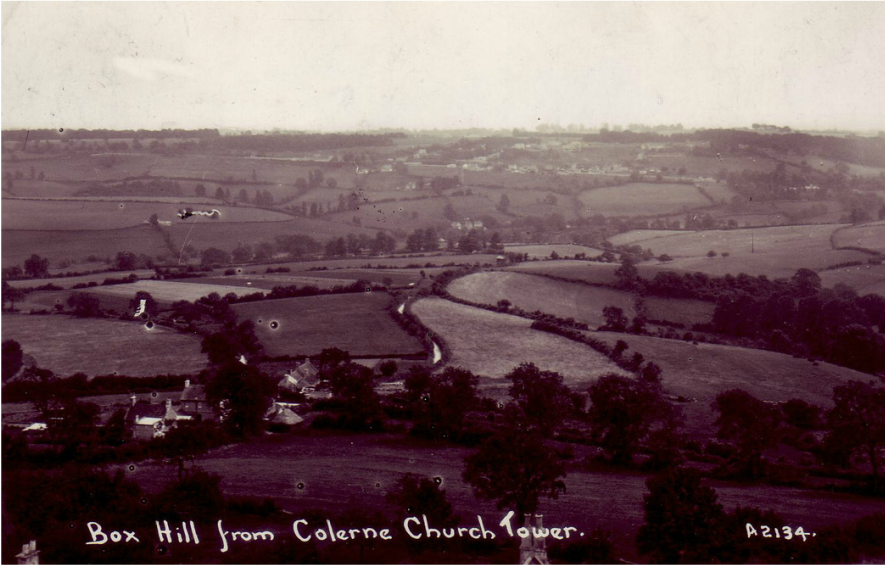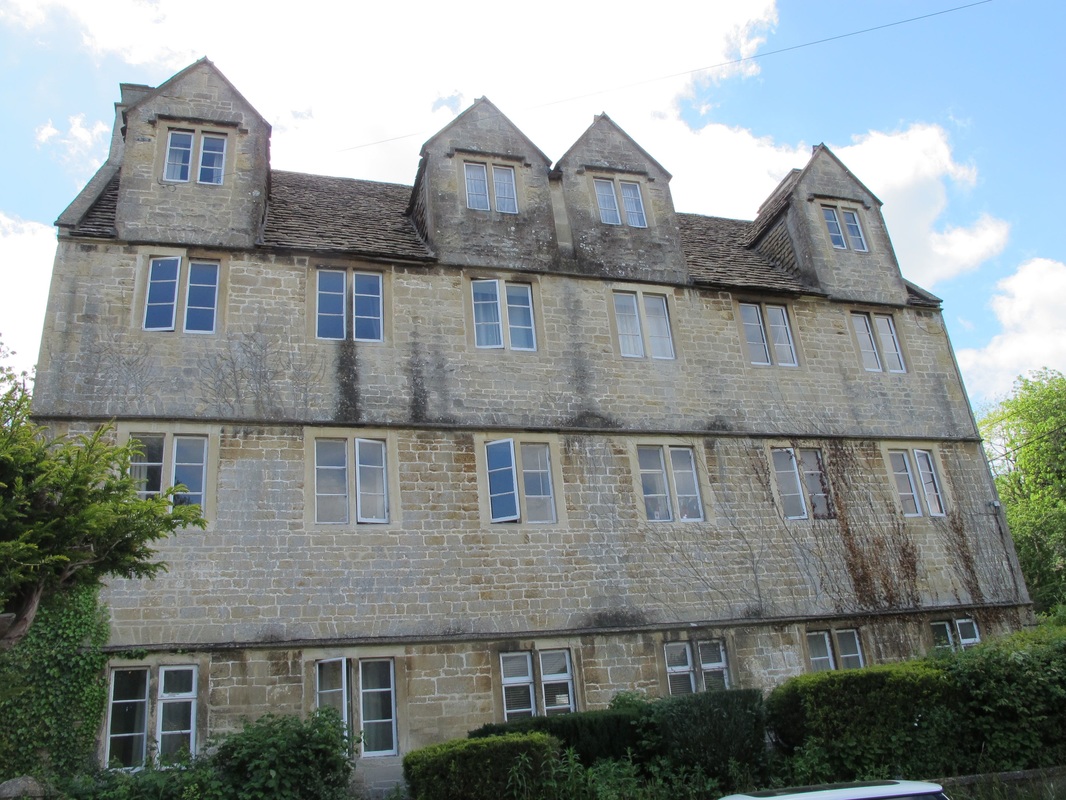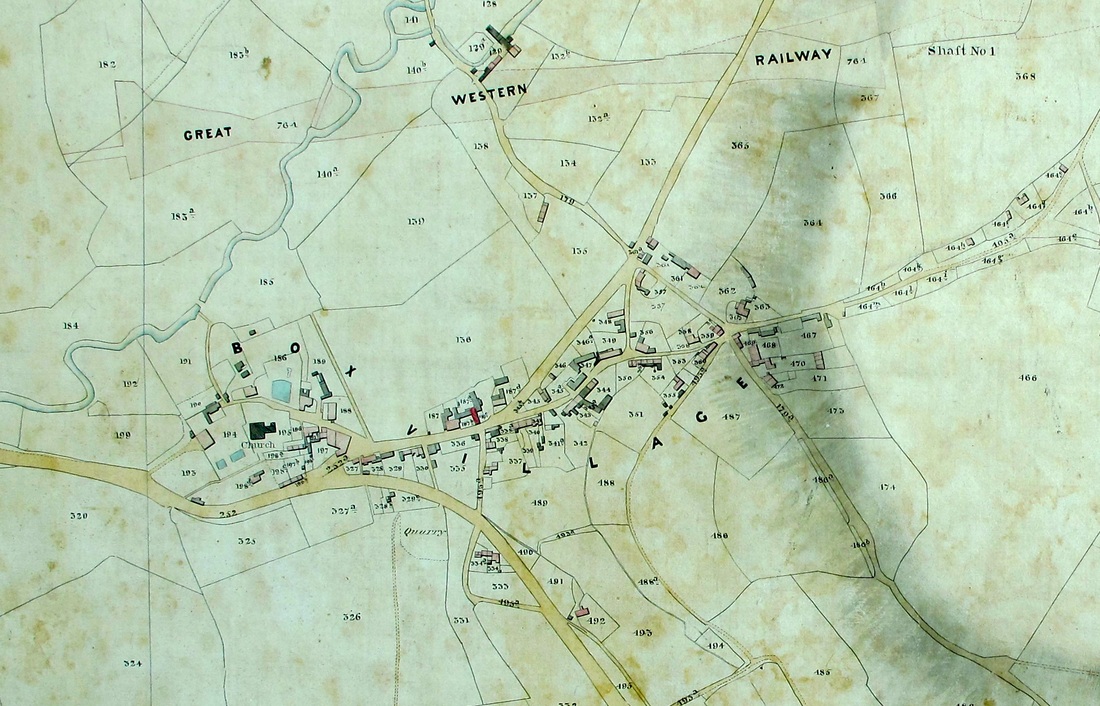Box Village in 1830 Alan Payne December 2016
Box was an idyllic rural retreat at the start of this period if we are to believe the writer John Britton in his book in 1825
"The Beauties of Wiltshire": The situation of Box is extremely picturesque, the village extending over the side of Kingsdown Hill and a portion of the vale beneath, which is watered by a rivulet called Box Brook. This valley consists of fertile meadows, bounded by steep hills, over the sides of which are scattered hamlets, villas, and woods, forming a rich variety of scenery. The soil of the higher ground is principally of the kind termed Stone-brash, consisting of fertile loam intermixed with flints and calcareous fragments. The sub-stratum is an extensive bed of freestone, of the peculiar sort called Bath-stone.[1]
Rural Poverty
But Box was a poor area in which to make a living. In 1830 William Cobbett, the essayist, described Wiltshire labourers in Rural Rides as the worst used ... on the face of the earth. There is a shocking decay, a great dilapidation and constant falling down of houses... The labourers’ houses disappear also. In Wiltshire he witnessed thirty men digging a field of 12 acres because it was cheaper than the cost of ploughing by machine.[2] He concluded, When farmers become gentlemen, their labourers become slaves.
The impact of the Napoleonic Wars with France was still being felt as the government sought to deal with national economic depression. Wages for farm labourers were forced down, whilst the price of bread rose, partly because of import duties (the Corn Laws) which the government imposed in 1815 to support farmers and partly because of poor harvests in successive years from 1828 to 1830.[3] In 1846-7 one sixth of the population of Wiltshire was receiving poor relief because wages were so low.[4]
It was a time of great social tension, brought about in part by fear of a social revolution similar to that in France. In March 1817 a riot at Radstock of 3,000 colliers calling for Bread or Blood was put down by calling out the 23rd Lancers.[5] There were serious riots at Bradford and Trowbridge against mechanisation and one man was killed at Melksham. In Wiltshire gangs of men with blackened faces led by a supposed Captain Swing burned down hayricks and barns and wrecked machinery in protest against enclosure of common land, low wages, and threshing machines and anything keeping local men out of work.[6] In1819 the notorious Peterloo Massacre witnessed a cavalry charge on peaceful parliamentary protesters in Manchester and the death of 15 innocent civilians.
The authorities were panicked into acts of repression marked by agents spying on the general population. By the end of 1830 over 2,000 rioters nationally were held in prison, some 500 of whom were transported and 19 hanged.[7]
"The Beauties of Wiltshire": The situation of Box is extremely picturesque, the village extending over the side of Kingsdown Hill and a portion of the vale beneath, which is watered by a rivulet called Box Brook. This valley consists of fertile meadows, bounded by steep hills, over the sides of which are scattered hamlets, villas, and woods, forming a rich variety of scenery. The soil of the higher ground is principally of the kind termed Stone-brash, consisting of fertile loam intermixed with flints and calcareous fragments. The sub-stratum is an extensive bed of freestone, of the peculiar sort called Bath-stone.[1]
Rural Poverty
But Box was a poor area in which to make a living. In 1830 William Cobbett, the essayist, described Wiltshire labourers in Rural Rides as the worst used ... on the face of the earth. There is a shocking decay, a great dilapidation and constant falling down of houses... The labourers’ houses disappear also. In Wiltshire he witnessed thirty men digging a field of 12 acres because it was cheaper than the cost of ploughing by machine.[2] He concluded, When farmers become gentlemen, their labourers become slaves.
The impact of the Napoleonic Wars with France was still being felt as the government sought to deal with national economic depression. Wages for farm labourers were forced down, whilst the price of bread rose, partly because of import duties (the Corn Laws) which the government imposed in 1815 to support farmers and partly because of poor harvests in successive years from 1828 to 1830.[3] In 1846-7 one sixth of the population of Wiltshire was receiving poor relief because wages were so low.[4]
It was a time of great social tension, brought about in part by fear of a social revolution similar to that in France. In March 1817 a riot at Radstock of 3,000 colliers calling for Bread or Blood was put down by calling out the 23rd Lancers.[5] There were serious riots at Bradford and Trowbridge against mechanisation and one man was killed at Melksham. In Wiltshire gangs of men with blackened faces led by a supposed Captain Swing burned down hayricks and barns and wrecked machinery in protest against enclosure of common land, low wages, and threshing machines and anything keeping local men out of work.[6] In1819 the notorious Peterloo Massacre witnessed a cavalry charge on peaceful parliamentary protesters in Manchester and the death of 15 innocent civilians.
The authorities were panicked into acts of repression marked by agents spying on the general population. By the end of 1830 over 2,000 rioters nationally were held in prison, some 500 of whom were transported and 19 hanged.[7]
End of Box's Poorhouse
In 1834 there was a momentous change in the way that village matters were conducted. For two centuries Box Parish had supported local people who were sick, unemployed or impoverished through rates paid by more fortunate locals. One of the crowning glories of the system was Box's Poorhouse, now called Springfield House, which housed those in need and provided an education to deserving children. But the rates system struggled to finance the number of working people applying for outdoor relief (a top-up of wages).[8] The 1801 census shows the repeated dependence of some Box families on poor relief; the Arlett and Bancroft families have 42 references in local records applying for assistance.[9]
The Poor Law Amendment Act of 1834 stopped this relief altogether and grouped together the parishes of Box, Colerne and Corsham into a central union with a single workhouse at Chippenham (now St Andrews Hospital). To discourage idleness, conditions within the union workhouse were made less comfortable than that of the poorest labourer. Poor food, petty restrictions and pointless occupations made the union workhouses little better than places of confinement for the destitute and the mentally or physically disadvantaged. Union workhouses became hated as a symbol of shame, depicted in Dicken's Oliver Twist, to which only the destitute would turn for help. In Box the Overseers of the Poor sought to mitigate the harshness of the Act by subsidising agricultural labourers and using the Poorhouse to house the destitute until 1879 when it was sold.[10]
In 1834 there was a momentous change in the way that village matters were conducted. For two centuries Box Parish had supported local people who were sick, unemployed or impoverished through rates paid by more fortunate locals. One of the crowning glories of the system was Box's Poorhouse, now called Springfield House, which housed those in need and provided an education to deserving children. But the rates system struggled to finance the number of working people applying for outdoor relief (a top-up of wages).[8] The 1801 census shows the repeated dependence of some Box families on poor relief; the Arlett and Bancroft families have 42 references in local records applying for assistance.[9]
The Poor Law Amendment Act of 1834 stopped this relief altogether and grouped together the parishes of Box, Colerne and Corsham into a central union with a single workhouse at Chippenham (now St Andrews Hospital). To discourage idleness, conditions within the union workhouse were made less comfortable than that of the poorest labourer. Poor food, petty restrictions and pointless occupations made the union workhouses little better than places of confinement for the destitute and the mentally or physically disadvantaged. Union workhouses became hated as a symbol of shame, depicted in Dicken's Oliver Twist, to which only the destitute would turn for help. In Box the Overseers of the Poor sought to mitigate the harshness of the Act by subsidising agricultural labourers and using the Poorhouse to house the destitute until 1879 when it was sold.[10]
New Society Arises
Against this background of change and uncertainty, a different social order arose in England with new wealth, beyond the imagination of previous generations. The change was based on industrialisation, manufacturing and the coming of coal and steam-generated power whether by railways or static engines. The changes were good for some who developed into what we call the middle class but to poor, rural labourers and the urban under-class it meant hardship, poverty and fear of change.[11]
And problems were exacerbated by an unprecedented population explosion in England which doubled from 8.6 million in 1801 to 17 million in 1851.[12]
The 1832 Great Reform Act enfranchised certain property-owning men, a total of one-in-six of adult males. It passed after much parliamentary manoeuvring which ended the authority of the Tory Party and led to the rise of the Whigs. They brought in a number of reforms: slavery abolished in 1833, Municipal Corporations started in 1835, and the reform of the death penalty, restricting it to cases of murder.
It was only a start in the creation of a modern country over the next decade. The first ever peacetime income tax of 7d in the £1 (3%) was introduced in 1842 for those earning over £150 a year. The Chartist movement burnt brightly in the 1840s demanding parliamentary change including universal manhood suffrage, secret ballots, equal constituencies and paid members of parliament. In 1846 the tax on corn, a basic universal foodstuff, was abolished, bringing a fairer concept of taxation which revolutionised British economic thought. The new era also witnessed the birth of a moral responsibility and concern for the welfare of the less advantaged through restrictions on working hours and child labour.
Against this background of change and uncertainty, a different social order arose in England with new wealth, beyond the imagination of previous generations. The change was based on industrialisation, manufacturing and the coming of coal and steam-generated power whether by railways or static engines. The changes were good for some who developed into what we call the middle class but to poor, rural labourers and the urban under-class it meant hardship, poverty and fear of change.[11]
And problems were exacerbated by an unprecedented population explosion in England which doubled from 8.6 million in 1801 to 17 million in 1851.[12]
The 1832 Great Reform Act enfranchised certain property-owning men, a total of one-in-six of adult males. It passed after much parliamentary manoeuvring which ended the authority of the Tory Party and led to the rise of the Whigs. They brought in a number of reforms: slavery abolished in 1833, Municipal Corporations started in 1835, and the reform of the death penalty, restricting it to cases of murder.
It was only a start in the creation of a modern country over the next decade. The first ever peacetime income tax of 7d in the £1 (3%) was introduced in 1842 for those earning over £150 a year. The Chartist movement burnt brightly in the 1840s demanding parliamentary change including universal manhood suffrage, secret ballots, equal constituencies and paid members of parliament. In 1846 the tax on corn, a basic universal foodstuff, was abolished, bringing a fairer concept of taxation which revolutionised British economic thought. The new era also witnessed the birth of a moral responsibility and concern for the welfare of the less advantaged through restrictions on working hours and child labour.
End of Medieval Tithes
Early Victorian society saw itself as sweeping away some of the historic anachronisms of the past. In 1836 the Tithe Commutation Act sought voluntary agreements (apportionments) to buy out (commute) the church tithes which still existed in two-thirds of the country. Tithes (the payment of one-tenth of all crops and produce) had existed since medieval times to support the church and its ministers. By Georgian times it was common for the lay rector (the owner of the right to appoint the minister) to be paid the great tithes of corn and wood, whilst the ordained vicar received the small tithes of animals, milk and wool.
Early Victorian society saw itself as sweeping away some of the historic anachronisms of the past. In 1836 the Tithe Commutation Act sought voluntary agreements (apportionments) to buy out (commute) the church tithes which still existed in two-thirds of the country. Tithes (the payment of one-tenth of all crops and produce) had existed since medieval times to support the church and its ministers. By Georgian times it was common for the lay rector (the owner of the right to appoint the minister) to be paid the great tithes of corn and wood, whilst the ordained vicar received the small tithes of animals, milk and wool.
The tithe system was deeply unpopular amongst farmers, particularly non-conformists who objected to supporting the Church of England. Its abolition was a major piece of reform, the recording of every field in the village, its ownership and who occupied it, in order that its tithe value could be determined and converted into rental values. The work of the tithe surveyors gives a wonderful picture of Box in about 1840 which some historians have likened to a modern Domesday survey.
Modern Box Starts
Against this background of national change we can see how these ideas were exemplified in Box by the coming of the railway and the quarrying trade after 1841. Box became part of a national network of transport and business interests which included all members of society promoted by the obligation of the railway companies to provide cheap parliamentary trains.
The changes were unacceptable for many rural people. Five hundred people emigrated from Wiltshire in the years 1839 to 1842, some funded by the Poor Law rates, some by local landowners. All sought to escape the severity of rural depression and to establish a better life in the New World. Some rural labour in Box was replaced by processing in new manufactories in the towns of Trowbridge and Melksham where water or steam power was used to drive rows of machines in the same building.
The period of two decades after 1830 changed rural Box for ever and encouraged the creation of the village which exists today.
Modern Box Starts
Against this background of national change we can see how these ideas were exemplified in Box by the coming of the railway and the quarrying trade after 1841. Box became part of a national network of transport and business interests which included all members of society promoted by the obligation of the railway companies to provide cheap parliamentary trains.
The changes were unacceptable for many rural people. Five hundred people emigrated from Wiltshire in the years 1839 to 1842, some funded by the Poor Law rates, some by local landowners. All sought to escape the severity of rural depression and to establish a better life in the New World. Some rural labour in Box was replaced by processing in new manufactories in the towns of Trowbridge and Melksham where water or steam power was used to drive rows of machines in the same building.
The period of two decades after 1830 changed rural Box for ever and encouraged the creation of the village which exists today.
References
[1] John Britton, Beauties of Wiltshire, 1825, p.189
[2] William Cobbett, Rural Rides, first published 1830
[3] Bruce Watkin, A History of Wiltshire, Phillimore & Co, 1989, p.93
[4] Victoria County History of Wiltshire, Vol IV, p.83
[5] The Times, 4 March 1817
[6] Christopher Hibbert, The English: A Social History 1066-1945, 1987, Harper Collins, p.490
[7] Christopher Hibbert, The English: A Social History 1066-1945, p.491
[8] Bruce Watkin, A History of Wiltshire, p.96
[9] Clare Higgens, Box Wiltshire - An Intimate History, 1985, The Downland Press, p.60
[10] John Ayers, A Christian & Useful Education, B-Ed Course, Wiltshire History Centre 2265, p.4
[11] The works of Dickens are testament to pace of change and the problems that modernisation brought from the poorhouse in Oliver Twist to the moral outrage of A Christmas Carol.
[12] Robert Tombs, The English and Their History, 2014, Allen Lane, p.431
[1] John Britton, Beauties of Wiltshire, 1825, p.189
[2] William Cobbett, Rural Rides, first published 1830
[3] Bruce Watkin, A History of Wiltshire, Phillimore & Co, 1989, p.93
[4] Victoria County History of Wiltshire, Vol IV, p.83
[5] The Times, 4 March 1817
[6] Christopher Hibbert, The English: A Social History 1066-1945, 1987, Harper Collins, p.490
[7] Christopher Hibbert, The English: A Social History 1066-1945, p.491
[8] Bruce Watkin, A History of Wiltshire, p.96
[9] Clare Higgens, Box Wiltshire - An Intimate History, 1985, The Downland Press, p.60
[10] John Ayers, A Christian & Useful Education, B-Ed Course, Wiltshire History Centre 2265, p.4
[11] The works of Dickens are testament to pace of change and the problems that modernisation brought from the poorhouse in Oliver Twist to the moral outrage of A Christmas Carol.
[12] Robert Tombs, The English and Their History, 2014, Allen Lane, p.431


